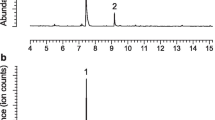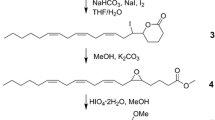Abstract
The compound 1-(1H–pyrrol-2-yl)-1,2-propanedione (“pyrrole”) is an important pheromone component of several Asian and South American species of longhorned beetles in the subfamily Cerambycinae. Here, we report the first confirmed identification of this compound as a pheromone component of a cerambycine species native to North America, the rare beetle Dryobius sexnotatus Linsley. Headspace volatiles from males contained (R)-3-hydroxyhexan-2-one and pyrrole (ratio 1:0.13), neither of which were detected in samples from a female. A field bioassay confirmed that adults of both sexes were attracted only to the binary blend of racemic 3-hydroxyhexan-2-one plus pyrrole, and not by either compound alone. Adults of another cerambycine, Xylotrechus colonus (F.), were attracted by 3-hydroxyhexan-2-one, consistent with this compound being the primary component of the pheromone of this species; attraction was not influenced by the presence of pyrrole. This study attests to the effectiveness of pheromone-baited traps in capturing rarely encountered species of cerambycids. It also provides further evidence that pyrrole represents another conserved pheromone motif within the Cerambycinae, now having been found in representatives of five cerambycid tribes from three continents.


Similar content being viewed by others
References
Cardé RT (2014) Defining attraction and aggregation pheromones: teleological versus functional perspectives. J Chem Ecol 40:519–520
Elliot AC, Hynan LS (2011) A SAS® macro implementation of a multiple comparison post hoc test for a Kruskal-Wallis analysis. Computer Meth Prog Biomed 102:75–80
Fonseca MG, Vidal DM, Zarbin PHG (2010) Male-produced sex pheromone of the cerambycid beetle Hedypathes betulinus: chemical identification and biological activity. J Chem Ecol 36:1132–1139
Graham EE, Mitchell RF, Reagel PF, Barbour JD, Millar JG, Hanks LM (2010) Treating panel traps with a fluoropolymer enhances their efficiency in capturing cerambycid beetles. J Econ Entomol 103:641–647
Hanks LM, Millar JG (2016) Sex and aggregation pheromones of cerambycid beetles: basic science and practical applications. J Chem Ecol 42:631–654
Hanks LM, Reagel PF, Mitchell RF, Wong JCH, Meier LR, Silliman CA, Graham EE, Striman BL, Robinson KP, Mongold-Diers JA, Millar JG (2014) Seasonal phenology of the cerambycid beetles of east-central Illinois. Ann Entomol Soc Am 107:211–226
Hayes RA, Griffiths MW, Nahrung HF, Arnold PA, Hanks LM, Millar JG (2016) Optimizing generic cerambycid pheromone lures for Australian biosecurity and biodiversity monitoring. J Econ Entomol 109:1741–1749
Imrei Z, Millar JG, Janik G, Tóth M (2013) Field screening of known pheromone components of longhorned beetles in the subfamily Cerambycinae (Coleoptera: Cerambycidae) in Hungary. Z Naturforsch 68c:236–242
Lacey ES, Millar JG, Moreira JA, Hanks LM (2009) Male-produced aggregation pheromones of the cerambycid beetles Xylotrechus colonus and Sarosesthes fulminans. J Chem Ecol 35:733–740
Lingafelter SW (2007) Illustrated key to the longhorned wood-boring beetles of the eastern United States. Special publication no. 3. Coleopterists Society, North Potomac
Linsley EG (1964) The Cerambycidae of North America: part V. Taxonomy and classification of the subfamily Cerambycinae, tribes Callichromini through Ancylocerini. Univ Calif Publ Entomol 22:1–197
Maier CT (2007) Distribution and hosts of Callidiellum rufipenne (Coleoptera: Cerambycidae), an Asian cedar borer established in the eastern United States. J Econ Entomol 100:1291–1297
McFall D, Karnes J (eds) (1995) A directory of Illinois nature preserves, vol 2. Illinois Department of Natural Resources, Springfield
Meier LR, Zou Y, Millar JG, Mongold-Diers JA, Hanks LM (2016) Synergism between enantiomers creates species-specific pheromone blends and minimizes cross-attraction for two species of cerambycid beetles. J Chem Ecol 42:1181–1192
Millar JG, Hanks LM (2017) Chemical ecology of cerambycids. In: Wang Q (ed) Cerambycidae of the world: biology and pest management. CRC Press/Taylor & Francis, Boca Raton, pp 161–208
Millar JG, Hanks LM, Moreira JA, Barbour JD, Lacey ES (2009) Pheromone chemistry of cerambycid beetles. In: Nakamuta K, Millar JG (eds) Chemical ecology of wood-boring insects. Forestry and Forest Products Research Institute, Ibaraki, pp 52–79
Mitchell RF, Reagel PF, Wong JCH, Meier LR, Silva WD, Mongold-Diers J, Millar JG, Hanks LM (2015) Cerambycid beetle species with similar pheromones are segregated by phenology and minor pheromone components. J Chem Ecol 41:431–440
Pajares JA, Álvarez G, Ibeas F, Gallego D, Hall DR, Farman DI (2010) Identification and field activity of a male-produced aggregation pheromone in the pine sawyer beetle, Monochamus galloprovincialis. J Chem Ecol 36:570–583
Pajares JA, Alvarez G, Hall DR, Douglas P, Centeno F, Ibarra N, Schroeder M, Teale SA, Wang Z, Yan S, Millar JG, Hanks LM (2013) 2-(Undecyloxy)-ethanol is a major component of the male-produced aggregation pheromone of Monochamus sutor. Entomol Exp Appl 149:118–127
Perry RH, Surdick RW, Anderson DM (1974) Observations on the biology, ecology, behavior, and larvae of Dryobius sexnotatus Linsley (Coleoptera: Cerambycidae). Coleopt Bull 28:169–176
SAS Institute (2011) SAS/STAT 9.3 user's guide. SAS Institute Inc., Cary
Sokal RR, Rohlf FJ (1995) Biometry, 3rd edn. W. H. Freeman, New York
Sweeney JD, Silk PJ, Grebennikov V (2014) Efficacy of semiochemical-baited traps for detection of longhorn beetles (Coleoptera: Cerambycidae) in the Russian far east. Eur J Entomol 111:397–406
Wickham JD, Harrison RD, Lu W, Guo Z, Millar JG, Hanks LM, Chen Y (2014) Generic lures attract cerambycid beetles in a tropical montane rain forest in southern China. J Econ Entomol 107:259–267
Wickham JD, Lu W, Zhang L-W, Chen Y, Zou Y, Hanks LM, Millar JG (2016) Likely aggregation-sex pheromones of the invasive beetle Callidiellum villosulum, and the related Asian species Allotraeus asiaticus, Semanotus bifasciatus, and Xylotrechus buqueti (Coleoptera: Cerambycidae). J Econ Entomol 109:2243–2246
Zar J (2010) Biostatistical analysis, 5th edn. Pearson Prentice-Hall, Upper Saddle River
Zou Y, Rutledge CE, Nakamuta K, Maier CT, Hanks LM, Richards AB, Lacey ES, Millar JG (2016) Identification of a pheromone component and a critical synergist for the invasive beetle Callidiellum rufipenne (Coleoptera: Cerambycidae). Environ Entomol 45:216–222
Acknowledgments
We appreciate collection of the initial beetle specimen for the collection of volatiles by Tyler Hedlund, and funding in support of research from the Alphawood Foundation of Chicago (to LMH), and Hatch Act project CA-R*ENT-5181-H (to JGM). This research was in partial fulfillment of a Masters degree for NMD from the University of Illinois at Urbana-Champaign.
Author information
Authors and Affiliations
Corresponding author
Rights and permissions
About this article
Cite this article
Diesel, N.M., Zou, Y., Johnson, T.D. et al. The Rare North American Cerambycid Beetle Dryobius sexnotatus Shares a Novel Pyrrole Pheromone Component with Species in Asia and South America. J Chem Ecol 43, 739–744 (2017). https://doi.org/10.1007/s10886-017-0875-3
Received:
Revised:
Accepted:
Published:
Issue Date:
DOI: https://doi.org/10.1007/s10886-017-0875-3




